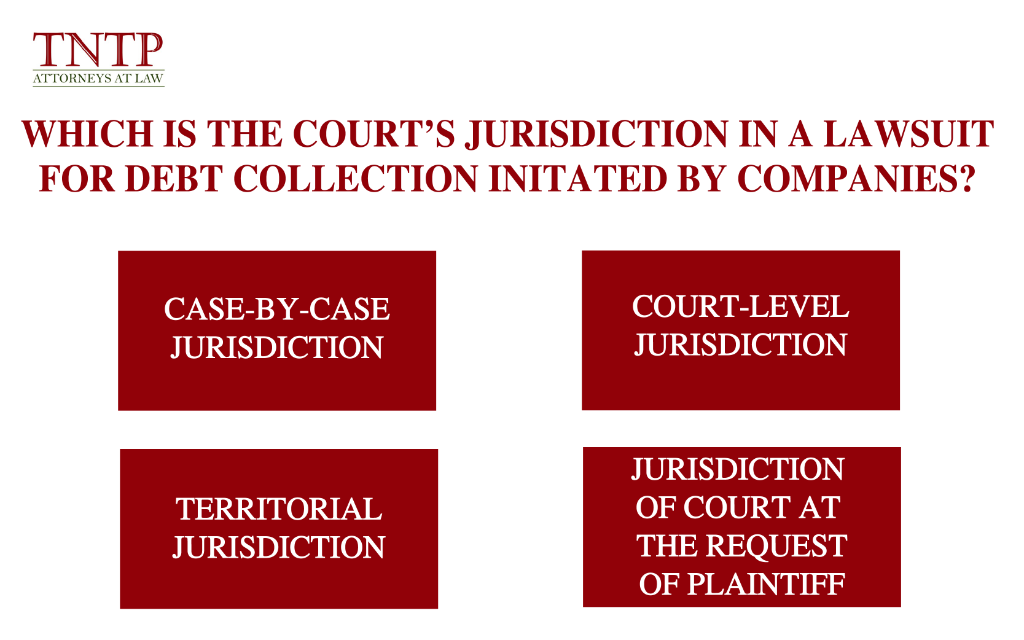When a contractual dispute arises, determining the Court’s jurisdiction is an important step for companies to initiate a lawsuit for debt collection. In the following article, TNTP will analyze the Court’s jurisdiction to settle contractual disputes determined in four steps as follows:
1. Case-by-case jurisdiction
Determining the court’s jurisdiction on a case-by-case basis is to determine whether the dispute falls under the Court’s jurisdiction. The Civil Procedure Code 2015 stipulates the Court’s jurisdiction on a case-by-case basis from Articles 26 to 34.
Specifically: The court’s jurisdiction to settle business and/or trade contract disputes is determined under Article 30.
2. Court-Level Jurisdiction
The Law on Organization of People’s Courts divides the Court’s jurisdiction into the following levels:
- The Supreme People’s Court;
- Superior people’s courts;
- Courts of provinces and centrally run cities (collectively referred to as the Courts of provinces);
- Courts of urban districts, rural districts, towns, provincial cities (collectively referred to as the Courts of districts);
- Military courts.
Courts of districts have jurisdiction over disputes specified in Articles 35 and 36 of the Civil Procedure Code; Courts of provinces have jurisdiction over disputes specified in Articles 37 and 38 of the Civil Procedure Code. Commercial business disputes fall under the jurisdiction of Courts of districts. For business and/or trade disputes involving foreign elements, the jurisdiction belongs to the Courts of provinces. In business disputes, both parties may be established and operate in Vietnam or either of them is established and operate outside the Vietnamese territory, in this case:
If a dispute arises between companies both established and operating in Vietnam, it will fall under the e jurisdiction of the People’s Court of district;
If the dispute is between companies with one of which is established and operating outside the Vietnamese territory, it will fall under the jurisdiction of the People’s Court of province.
3. Territorial Jurisdiction
The territorial jurisdiction of Courts to settle contractual disputes shall be determined as follows:
The Courts of the localities where the defendants reside or work, applicable to defendants being individuals, or where the defendants are headquartered, applicable to defendants being agencies or organizations, shall have the jurisdiction to settle according to first-instance procedures for business contract disputes prescribed in Articles 30 of Civil Procedure Code;
The involved parties shall have the right to agree with each other in writing to petition the Courts of the localities where the plaintiffs reside or work, applicable to plaintiffs being individuals, or where the plaintiffs are headquartered, applicable to plaintiffs being agencies or organizations, to settle business and/or trade disputes prescribed in Articles 30 of this Code;
Disputes over real estate must be settled by Courts where such real estate is located.
4. Jurisdiction of Court at the request of Plaintiff
The plaintiff has the right to choose a court to resolve business and/or trade contract disputes in the cases specified in Clause 1, Article 40 of the Civil Procedure Code:
a) If the plaintiff does not know where the defendant resides or works or where his/her head office is located, the plaintiff may petition the Courts of the area where the defendant last resides or works or where the head office of the defendant is last located or where the defendant’ properties are located to settle the case;
b) If the dispute arises from the operation of a branch of an organization, the plaintiff may petition the Court of the area where the organization’s head office is located or where its branch is located to settle it;
c) If the defendant does not have a residence place, workplace or head office in Vietnam or the case is related to disputes over alimonies, the plaintiff may petition the Court of the area where he/she resides or works to settle the case;
g) If the dispute arises from a contractual relation, the plaintiff may petition the Court of the area where the contract is performed to settle the case;
h) If the defendants reside, work or are headquartered in different places, the plaintiff may petition the Court of the area where one of the defendants resides or works or is headquartered to settle the case;
i) If the dispute is over immovables which exist in different localities, the plaintiff may request the Court of the area where one of such immovables exists to settle the dispute.
After properly determining the Court’s jurisdiction, the authorized Court receives and reviews the lawsuit petition. If the lawsuit petition is valid, the court shall notify the plaintiff of the payment of fees and court cost advances. After receiving the fee receipt and the court cost advance, the court officially accepts the case.
Accordingly, enterprises can base on the Court’s jurisdiction to settle contractual disputes to determine where to file a lawsuit petition for debt collection or dispute settlement, to save time and avoid the fact that the petition has to be re-transferred to the competent court for settlement.
Thus, to maximize the protection of companies’ legitimate rights and interests by the law, companies should pay attention to the Court’s jurisdiction matter. Above are the sharing of TNTP on determining the jurisdiction of the Court in a lawsuit for debt collection. We hope it is useful to companies.
Sincerely.







